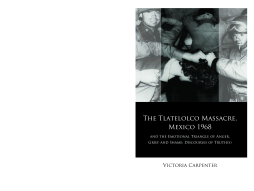
BOOK
The Tlatelolco Massacre, Mexico 1968, and the Emotional Triangle of Anger, Grief and Shame
(2018)
Additional Information
Book Details
Abstract
In the aftermath of major violent events that affect many, we seek to know the ‘truth’ of what happened. Whatever ‘truth’ emerges relies heavily on the extent to which any text about a given event can stir our emotions – whether such texts are official sources or the ‘voice of the people’, we are more inclined to believe them if their words make us feel angry, sad or ashamed. If they fail to stir emotion, however, we will often discount them even when the reported information is the same. Victoria Carpenter analyses texts by the Mexican government, media and populace published after the Tlatelolco massacre of 2 October 1968, demonstrating how there is no strict division between their accounts of what happened and that, in fact, different sides in the conflict used similar and sometimes the same images and language to rouse emotions in the reader.
Table of Contents
| Section Title | Page | Action | Price |
|---|---|---|---|
| Cover\r | Cover | ||
| Half Title | i | ||
| Series Editors | ii | ||
| Title | iii | ||
| Copyright\r | iv | ||
| Dedication\r | v | ||
| Contents | vii | ||
| List of Tables | ix | ||
| Series Editors’ Foreword | xi | ||
| Acknowledgements | xiii | ||
| 1 Introduction: ‘2 October Is Not Forgotten’ | 1 | ||
| 2 ‘And All This Happened toUs’: Events of the Night of 2 October in the State and Public Discourses | 30 | ||
| 3 Affect and Reason: Analysis of the Massacre in the State and Public Discourses | 91 | ||
| 4 ‘Unfortunate and Sad Fate’: Emotional Reaction to the Massacre in the State and Public Discourses | 135 | ||
| 5 Conclusion: The Symbolic Value of ‘2 October Is Not Forgotten’ | 177 | ||
| Notes | 183 | ||
| Bibliography | 221 | ||
| Index | 233 | ||
| Back Cover | Back-Cover |
